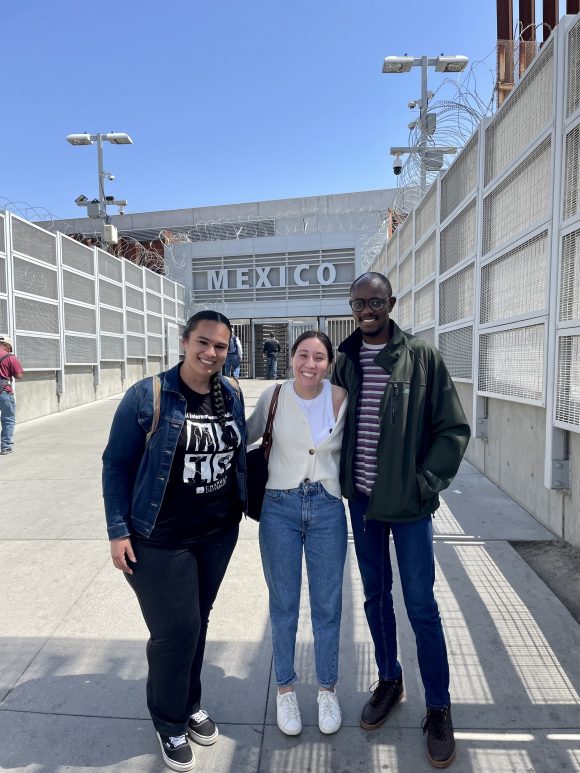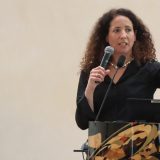
Experiential Learning at the Mexico/US Border
June 24, 2022
Students of the MA in International Studies (MAIS) program had the opportunity to visit the Mexico-United States port of entry between San Ysidro and Tijuana, referred to as the “world’s busiest border crossing.” The trip was also the culminating project in Dr. Nancy Rios-Contreras’s MAIS Refugees and Migration course, which covered topics relevant to asylum, borders, and transit migration.

Dr. Nancy Rios-Contreras, Montserrat Bugueno ’22 (MA International Studies), Socrates Mbamalu (MA War and Society).
Students first visited the east pedestrian crossing and walked to the Mexico entrance to see the large Mexico sign with Concertina wire. As students observed the various layers of wall construction, life at the border continued as transborder migrants exited the United States and entered Mexico. Students then walked to the East Pedestrian Building of the San Ysidro Land Port of Entry and peeked in to see United States Customs and Border Protection officials carry out inspections leading to the San Ysidro Trolley Station. Students also walked to the west pedestrian crossing to see the side of the port of entry that has been closed since the arrival of Central American asylum seekers and the Covid-19 pandemic. Students discussed the complexity of the border with unhoused migrants experiencing hunger on the Mexican side and the Las Americas Premium Outlets for brand-name shopping in the United States.
“Personally, the Tijuana port of entry was intimidating,” said MAIS student and recent alum Montserrat Bugueno. “As an immigrant, it reminded me of my privilege, which I have not earned but was born with, highlighting the inequalities of migration.”
The trip ended with a visit to Chicano Park, located in the Barrio Logan of San Diego. It has the largest concentration of Chicano murals in the world and allows students to learn about the migrant experience beyond the border. Students saw murals of indigenous history, the United Farm Workers Movement, police brutality, and celebrations of Mexican American pride.
“Chicano Park is an emblem of resistance and history in a city that is fully aware of the power of the state and how it has been used disproportionately, targeting a specific group of people” said War, Diplomacy, and Society MA student Socrates Mbamalu.
“The Mexico-United States border is a place many dream and debate about, but few actually get to visit,” said Dr. Rios-Contreras, “Taking MAIS students to see the border wall and Chicano Park was the ultimate opportunity to learn about migration outside of the classroom walls.”
Dr. Rios-Contreras also organized experiential learning opportunities inside the classroom walls. Testimonio: A Borderlands Speaker Series, invited specialists in human rights defenders, documentarians, sociologists, and anthropologists to discuss with students their work at the US/Mexico border, and how these challenges and opportunities can inform their own humanitarian research and activity efforts. Invited guests included Andrea Rincon, Director and Founder of Border Youth, documentarian and director Gabriela Cortes, filmmaker and sociologist Michelle Rincon, and social anthropologist and photographer Lisbeth Chavez.
Through these experiential learning opportunities and others, a cornerstone of MAIS programing, students gain a deeper understanding of migration and learn to understand asylum politics and border enforcement in a humanistic manner.

